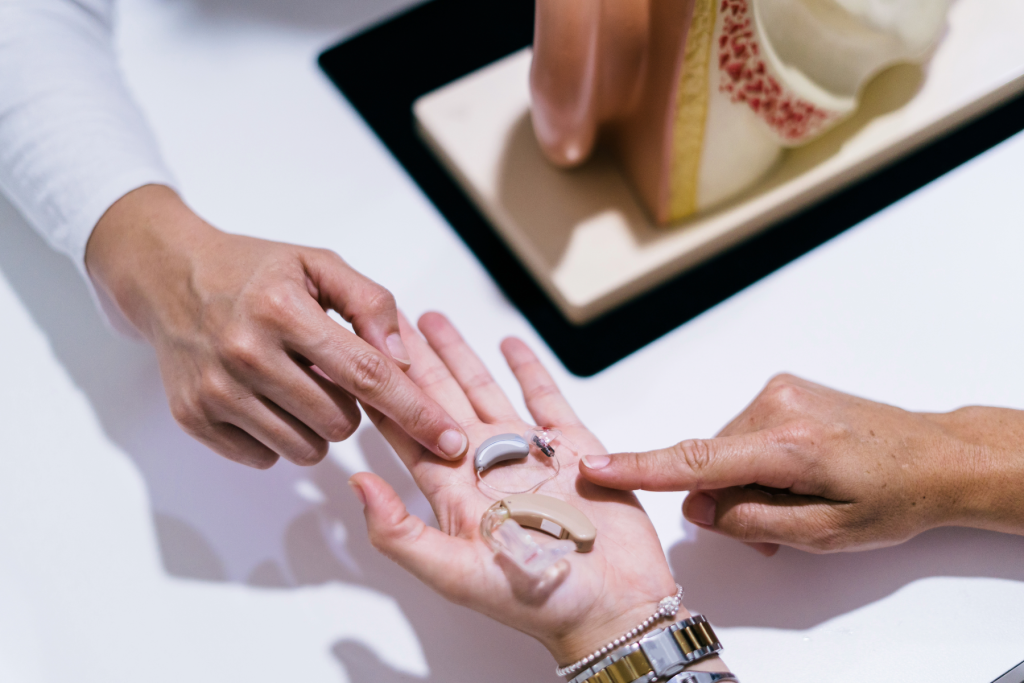


Hearing Aids
Hearing aids are a widely utilized non-invasive therapeutic modality for addressing hearing loss. These small electronic devices are typically worn in or behind the ear to amplify sounds, thereby enhancing listening and communication abilities. However, it is important to note that despite their effectiveness in mitigating hearing impairment, hearing aids do not provide a cure for this condition, nor do they restore normal auditory function to the ear.
Hearing aids do more than amplify sound—they help you reconnect with the world around you. Whether it’s enjoying conversations, staying safe, or feeling more confident in daily life, the benefits are life-changing.
- Better communication with friends, family, and coworkers
- Enhanced quality of life
- Cognitive health support
- Greater safety and awareness
- Reduced listening efforts
How Do Hearing Aids Work?
Hearing aids are small, advanced devices designed to improve how you hear and engage with the world around you. They have three main components that work together seamlessly:
- Microphone: Captures sounds from your environment and converts them into electrical signals.
- Amplifier: Increases the strength of the signals, adjusting volume and clarity based on your specific hearing needs.
- Speaker (Receiver): Delivers the enhanced sound directly into your ear so you can hear more clearly.
Hearing Aid Services
Hanover Audiology provides comprehensive services for all of your hearing aid needs. Our specialized approach involves meticulous evaluation of your hearing, personal lifestyle, and budget to select the most suitable hearing solution. Our services encompass hearing aid cleaning, repair, maintenance, and reprogramming, even if the devices were purchased elsewhere.
We are proud to offer the following array of services:
- Hearing aids sales & service (all major brands)
- Hearing aid programming/reprogramming
- Hearing instrument supplies & batteries
- Sales & service of Assistive Listening Devices
- Custom ear molds, headphones, and swim plugs
- Custom hearing/music/noise protection devices
Hearing Aid Brands
As an independent dealer offering a variety of top-quality brands, you have the unique advantage of flexibility and choice. We strive to enhance your quality of life through expert care and innovative technology.

Hearing Aid Styles
Hearing aids aren’t one-size-fits-all, each person’s hearing needs, lifestyle, and preferences are unique. From discreet in-the-ear models to powerful behind-the-ear devices, we’ll help you choose a style that fits both your hearing profile and your daily life. When recommending a hearing aid, we consider a range of factors, including:
- Lifestyle and listening environments
- Type and degree of hearing loss
- Personal style and comfort
- Medical or anatomical considerations
- Dexterity
Behind the Ear (BTE) Hearing Aids
Behind-the-ear (BTE) hearing aids are a versatile option for individuals with mild to profound hearing loss. These devices rest comfortably behind the ear and are connected to a custom earmold or a slim tube that directs sound into the ear canal.
BTE hearing aids are known for their durability, power, and ability to support a range of advanced features like directional microphones, program settings, and volume controls. Modern BTEs come in both traditional and sleek, low-profile designs. With a variety of sizes, colors, and tubing options available, they can be tailored to your hearing needs, lifestyle, and personal style.
Receiver in Canal (RIC) Hearing Aids
RIC models are mini BTEs that have the instrument’s speaker incorporated in the ear tip instead of in the main body of the device. RIC instruments fit mild-to-severe hearing losses.
Custom Hearing Aids
Custom hearing aids are uniquely molded to fit the shape of your ear for maximum comfort, discretion, and performance. These in-ear styles range in size and functionality, offering personalized options for various degrees of hearing loss and lifestyle needs. Custom hearing aids are all about comfort, clarity, and confidence—tailored just for you.
- Completely-in-Canal (CIC): These ultra-discreet devices sit deep in the ear canal, making them nearly invisible. Best suited for mild to moderate hearing loss, CICs offer a natural sound experience with minimal wind noise but have fewer manual controls due to their small size.
- In-the-Canal (ITC): ITC hearing aids fit partially in the canal and are slightly larger than CIC models. They offer a great balance of discretion and functionality, with room for features like directional microphones and volume control—ideal for mild to moderately severe hearing loss.
- In-the-Ear (ITE): These fill more of the outer ear and are easier to handle. Suitable for mild to severe hearing loss, ITE devices can house more powerful components but are typically not recommended for children, as their ears are still growing.
Reconnect with the sounds that matter most.
Contact us to get started on your hearing care journey.


Hearing Aids
Hearing aids are a widely utilized non-invasive therapeutic modality for addressing hearing loss. These small electronic devices are typically worn in or behind the ear to amplify sounds, thereby enhancing listening and communication abilities. However, it is important to note that despite their effectiveness in mitigating hearing impairment, hearing aids do not provide a cure for this condition, nor do they restore normal auditory function to the ear.
Hearing aids do more than amplify sound—they help you reconnect with the world around you. Whether it’s enjoying conversations, staying safe, or feeling more confident in daily life, the benefits are life-changing.
- Better communication with friends, family, and coworkers
- Enhanced quality of life
- Cognitive health support
- Greater safety and awareness
- Reduced listening efforts
How Do Hearing Aids Work?
Hearing aids have three main components that work together seamlessly:
- Microphone: Captures sounds from your environment and converts them into electrical signals.
- Amplifier: Increases the strength of the signals, adjusting volume and clarity based on your specific hearing needs.
- Speaker (Receiver): Delivers the enhanced sound directly into your ear so you can hear more clearly.
Hearing Aid Services
Hanover Audiology provides comprehensive services for all of your hearing aid needs. Our specialized approach involves meticulous evaluation of your hearing, personal lifestyle, and budget to select the most suitable hearing solution. Our services encompass hearing aid cleaning, repair, maintenance, and reprogramming, even if the devices were purchased elsewhere.
We are proud to offer the following array of services:
- Hearing aids sales & service (all major brands)
- Hearing aid programming/reprogramming
- Hearing instrument supplies & batteries
- Sales & service of Assistive Listening Devices
- Custom ear molds, headphones, and swim plugs
- Custom hearing/music/noise protection devices
Hearing Aid Brands
As an independent dealer offering a variety of top-quality brands, you have the unique advantage of flexibility and choice. We strive to enhance your quality of life through expert care and innovative technology.

Hearing Aid Styles
Hearing aids aren’t one-size-fits-all, each person’s hearing needs, lifestyle, and preferences are unique. From discreet in-the-ear models to powerful behind-the-ear devices, we’ll help you choose a style that fits both your hearing profile and your daily life. When recommending a hearing aid, we consider a range of factors, including:
- Lifestyle and listening environments
- Type and degree of hearing loss
- Personal style and comfort
- Medical or anatomical considerations
- Dexterity
Behind the Ear (BTE)
Behind-the-ear (BTE) hearing aids are a versatile option for individuals with mild to profound hearing loss. These devices rest comfortably behind the ear and are connected to a custom earmold or a slim tube that directs sound into the ear canal.
BTE hearing aids are known for their durability, power, and ability to support a range of advanced features like directional microphones, program settings, and volume controls. Modern BTEs come in both traditional and sleek, low-profile designs. With a variety of sizes, colors, and tubing options available, they can be tailored to your hearing needs, lifestyle, and personal style.
Receiver in Canal (RIC)
RIC models are mini BTEs that have the instrument’s speaker incorporated in the ear tip instead of in the main body of the device. RIC instruments fit mild-to-severe hearing losses.
Custom Hearing Aids
Custom hearing aids are uniquely molded to fit the shape of your ear for maximum comfort, discretion, and performance. These in-ear styles range in size and functionality, offering personalized options for various degrees of hearing loss and lifestyle needs. Custom hearing aids are all about comfort, clarity, and confidence—tailored just for you.
- Completely-in-Canal (CIC): These ultra-discreet devices sit deep in the ear canal, making them nearly invisible. Best suited for mild to moderate hearing loss, CICs offer a natural sound experience with minimal wind noise but have fewer manual controls due to their small size.
- In-the-Canal (ITC): ITC hearing aids fit partially in the canal and are slightly larger than CIC models. They offer a great balance of discretion and functionality, with room for features like directional microphones and volume control—ideal for mild to moderately severe hearing loss.
- In-the-Ear (ITE): These fill more of the outer ear and are easier to handle. Suitable for mild to severe hearing loss, ITE devices can house more powerful components but are typically not recommended for children, as their ears are still growing.
Reconnect with the sounds that matter most.
Contact us to get started on your hearing care journey.
Hearing Aids
Hearing aids are a widely utilized non-invasive therapeutic modality for addressing hearing loss. These small electronic devices are typically worn in or behind the ear to amplify sounds, thereby enhancing listening and communication abilities. However, it is important to note that despite their effectiveness in mitigating hearing impairment, hearing aids do not provide a cure for this condition, nor do they restore normal auditory function to the ear.
Hearing aids do more than amplify sound—they help you reconnect with the world around you. Whether it’s enjoying conversations, staying safe, or feeling more confident in daily life, the benefits are life-changing.
- Better communication with friends, family, and coworkers
- Enhanced quality of life
- Cognitive health support
- Greater safety and awareness
- Reduced listening efforts
How Do Hearing Aids Work?
Hearing aids are small, advanced devices designed to improve how you hear and engage with the world around you. They have three main components that work together seamlessly:
- Microphone: Captures sounds from your environment and converts them into electrical signals.
- Amplifier: Increases the strength of the signals, adjusting volume and clarity based on your specific hearing needs.
- Speaker (Receiver): Delivers the enhanced sound directly into your ear so you can hear more clearly.
Hearing Aid Services
Hanover Audiology provides comprehensive services for all of your hearing aid needs. Our specialized approach involves meticulous evaluation of your hearing, personal lifestyle, and budget to select the most suitable hearing solution. Our services encompass hearing aid cleaning, repair, maintenance, and reprogramming, even if the devices were purchased elsewhere.
We are proud to offer the following array of services:
- Hearing aids sales & service (all major brands)
- Hearing aid programming/reprogramming
- Hearing instrument supplies & batteries
- Sales & service of Assistive Listening Devices
- Custom ear molds, headphones, and swim plugs
- Custom hearing/music/noise protection devices
Hearing Aid Brands
As an independent dealer offering a variety of top-quality brands, you have the unique advantage of flexibility and choice. We strive to enhance your quality of life through expert care and innovative technology.

Hearing Aid Styles
Hearing aids aren’t one-size-fits-all, each person’s hearing needs, lifestyle, and preferences are unique. From discreet in-the-ear models to powerful behind-the-ear devices, we’ll help you choose a style that fits both your hearing profile and your daily life. When recommending a hearing aid, we consider a range of factors, including:
- Lifestyle and listening environments
- Type and degree of hearing loss
- Personal style and comfort
- Medical or anatomical considerations
- Dexterity
Behind the Ear (BTE) Hearing Aids
Behind-the-ear (BTE) hearing aids are a versatile option for individuals with mild to profound hearing loss. These devices rest comfortably behind the ear and are connected to a custom earmold or a slim tube that directs sound into the ear canal.
BTE hearing aids are known for their durability, power, and ability to support a range of advanced features like directional microphones, program settings, and volume controls. Modern BTEs come in both traditional and sleek, low-profile designs. With a variety of sizes, colors, and tubing options available, they can be tailored to your hearing needs, lifestyle, and personal style.
Receiver in Canal (RIC) Hearing Aids
RIC models are mini BTEs that have the instrument’s speaker incorporated in the ear tip instead of in the main body of the device. RIC instruments fit mild-to-severe hearing losses.
Custom Hearing Aids
Custom hearing aids are uniquely molded to fit the shape of your ear for maximum comfort, discretion, and performance. These in-ear styles range in size and functionality, offering personalized options for various degrees of hearing loss and lifestyle needs. Custom hearing aids are all about comfort, clarity, and confidence—tailored just for you.
- Completely-in-Canal (CIC): These ultra-discreet devices sit deep in the ear canal, making them nearly invisible. Best suited for mild to moderate hearing loss, CICs offer a natural sound experience with minimal wind noise but have fewer manual controls due to their small size.
- In-the-Canal (ITC): ITC hearing aids fit partially in the canal and are slightly larger than CIC models. They offer a great balance of discretion and functionality, with room for features like directional microphones and volume control—ideal for mild to moderately severe hearing loss.
- In-the-Ear (ITE): These fill more of the outer ear and are easier to handle. Suitable for mild to severe hearing loss, ITE devices can house more powerful components but are typically not recommended for children, as their ears are still growing.
Reconnect with the sounds that matter most.
Contact us to get started on your hearing care journey.

